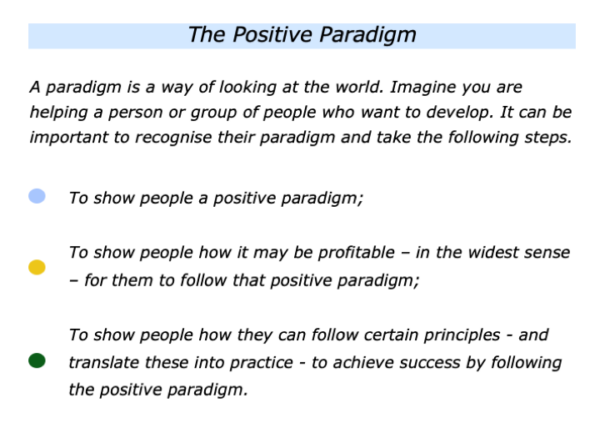
A paradigm is a way of looking at the world. The paradigm that we have often influences our daily actions. It can also have consequences for both ourselves and other people.
Imagine that you are working with a person, team or organisation that wants to develop. It can be important to recognise their present paradigm and then to take the following steps.
To show them a positive paradigm;
To show how it may be profitable – in the widest sense – for them to follow that positive paradigm;
To show how they can follow certain principles – and translate these into practice – to achieve success by following the positive paradigm.
If appropriate, you can then enable people to follow this approach successfully.
The importance of paradigm shifts was popularised by Thomas Kuhn in his 1962 article on The Structure of Scientific Revolutions. He explained how breakthroughs in science sometimes come from seeing the world in a different way.
Since then it has been used to illustrate the importance of recognising or creating such paradigm shifts in many aspects of life. This approach can take many forms.
A person who has a heart attack may choose to adopt a healthier lifestyle. A company whose culture is toxic and unprofitable may aim to develop a healthier model. A country that is dependent on fossil fuels may decide it is more profitable in the long run to focus on renewables.
There are several models that are similar to the paradigm approach. These include the following approaches.
The Belief Systems Approach
People have belief systems about how they and others can live, work and behave during their time on the planet. These may be based on certain philosophies, spiritual faiths or other views about how to live life.
Individuals and groups sometimes confirm these beliefs by applying confirmation bias. They look for things that confirm their beliefs rather than those that may challenge them to develop their beliefs. This leads the statement:
“We see what we believe rather than believe what we see.”
Belief systems can lead to people behaving in ways that may help or hurt themselves or other people. It can be challenging for them to change their belief systems.
This is because they have so much invested in their view of the world. People may therefore keep doing the same things even if these do not work. Sometimes they simply double-down and say things like:
“The reason it is not working is that we have not done it hard enough.”
Individuals, organisations and societies may keep following their chosen beliefs even though there may be another way that would bring better results. They may only change when they see a way that – in the widest sense of the word – is more profitable.
Individuals can get into difficulties because they follow certain beliefs. Some therapeutic approaches, for example, invite people to explore these in order to bring about change.
Albert Ellis took this approach when creating Rational Emotive Behaviour Therapy. This focused on helping people to understand and, if appropriate, change their belief system.
Here is an excerpt from the REBT website. This is followed by an illustration of one interpretation of the approach.
REBT is a pioneering form of cognitive behaviour therapy developed by Dr. Albert Ellis in 1955. According to REBT, it is largely our thinking about events that leads to emotional and behavioural upsets.
With the emphasis on the present, individuals are taught how to examine and challenge their unhelpful thinking which creates unhealthy emotions and self-defeating behaviours.
REBT than provides a variety of method to help people to reformulate their beliefs into ones that are more helpful. This can help people to enhance their emotional health and personal welfare.
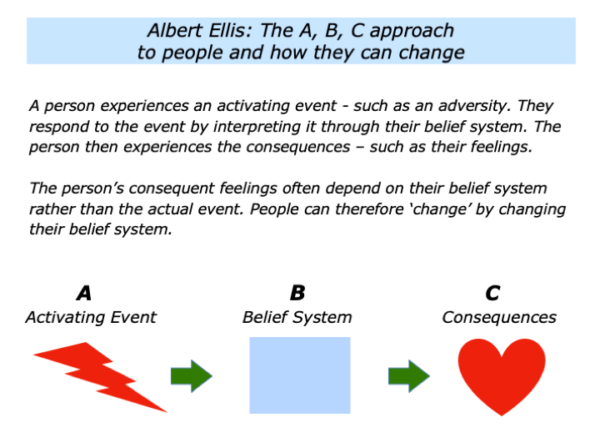
The beliefs system approach is mirrored in other ways of looking at the world. Here is a similar model.
The Mental Models Approach
A person uses mental models to interpret and decide how they will behave in certain situations. Here is one definition of mental models from the fs website.
Mental models are how we understand the world. Not only do they shape what we think and how we understand but they shape the connections and opportunities that we see.
Different people obviously have different mental models. A person who has the mental model that conflicts call for ‘win-lose’ outcomes, for example, will behave differently from one who believes in finding ‘win-win’ solutions.
People can add to their mental models. This can expand their repertoire of tools for shaping both their own and other people’s futures.
The Mindset Approach
This mindset approach is similar to that described in the piece on mental models. A person’s mindset embraces their attitude and how they approach doing things.
Some individuals have a positive mindset. They see possibilities and, when necessary, overcome setbacks when working towards their picture of success.
Some individuals have negative mindsets. They see problems and find it difficult to tackle challenges. They may tend to drift rather than be decisive in life.
There are many definitions for the concept of mindsets. The Berkeley Well-Being Institute defines this in the following way.
Mindset is defined as the set of attitudes or beliefs that we hold. Mindset is crucially important because our attitudes and beliefs affect everything we do, feel, think, and experience.
Our mindset influences our perceptions and how we move through the world.
Although we have one overall mindset, this can be made up of many smaller mindsets. Some of these help us improve our well-being and succeed in the world. Others hurt our ability to do so.
That’s why developing certain mindsets can greatly help us reach our goals, enjoy our lives, and be more successful.
The Personal Scripting Approach
People may follow certain internal scripts in some situations. These scripts act like programmes that they follow to interpret and respond to experiences.
Individuals sometimes learn scripts growing up in the family and in other situations. Their parents, for example, may give a child messages such as:
“You can aim to enjoy life and become the best you can be.”
Some children grow up being given different messages. A child may be told:
“You need to recognise that life is a competition and that you need to keep winning.”
People may internalise the messages they are given. They then find themselves reacting in certain ways to situations – almost as if they are following a programme. Such scripts can be helpful or unhelpful.
Somebody with a positive script may react to a setback by taking responsibility. They may say:
“I can make things happen and shape my future.”
A person with a negative script may react to a setback by seeing this as evidence that the world is against them. They may say:
“Things happen to me and there is little I can do to shape my future.”
Some of the work I did when running therapy programmes involved focusing on scripts. It involved helping a person: a) to recognise their script; b) to, if appropriate, rewrite their script; c) to follow their chosen script and achieve their picture of success.
The Positive Paradigm Approach In Action
There are many ways to translate this approach into action. There are certain rules to follow when sharing this approach in ways that are likely to resonate with people. One approach is to bear in mind the principles followed by good educators.
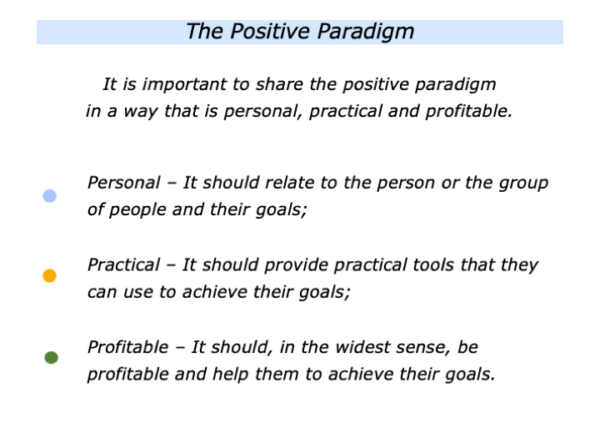
People are more likely to do something if they can see how it will benefit themselves or other people. Let’s explore some of the approaches for making this happen.
The Picture Of Success Approach
This involves focusing on the real results a person, team or organisation wants to achieve. You can the aim:
To focus on their picture of success
To focus on the benefits of achieving the picture of success;
To focus on the strategies they can follow to achieve the picture of success.
If appropriate, you can then help them to follow their chosen strategies to achieve the picture of success.
The Positive Models Approach
People are more likely to behave in a certain way if they believe this can help them succeed. They can learn how to take these steps from two sorts of positive models.
People can learn from other
people who act as positive models
They can learn from others they admire or want to emulate. This is an approach that I used when working with troubled young people. We helped them to learn from other people:
Who had been through similar difficulties;
Who had followed certain strategies to overcome the difficulties;
Who had managed to sustain success.
People who act as models can offer inspiration and ideas we can use to achieve our goals. They offer us a positive paradigm.
People can learn from positive models – such as philosophies
and frameworks – that help them to make sense of life
Such models can also provide people with tools that they can use to achieve success. Good educators, for example, often pass on such frameworks by going through the following steps.
They focus on a specific theme that they believe people may want to pursue to achieve success;
They study what works in this area and then translate this into a positive model and practical tools that people can use to achieve success;
They pass on this knowledge in ways that people can use to achieve their pictures of success.
Sharing such models with people – and showing how they can follow these frameworks – can offer them positive paradigms.
The Success Stories Approach
People buy success rather than the theory of success. Bearing this in mind, it can be useful to show people what works. This is an approach that is often used when shifting a culture in an organisation.
The first step is to clarify the principles you would like people to follow to achieve success. The second step is to look for when people have followed some of these principles to do good work. The third step is to produce success stories that highlight how people translated these principles into action to deliver success.
People can then be encouraged to follow these principles to continue to deliver success. The aim is to keep showing what good looks like. It is important to maintain the momentum, however, by continuing to produce success stories.
Different people use the success stories approach in different ways. Whichever route they follow, however, it sometimes involves taking the following steps.
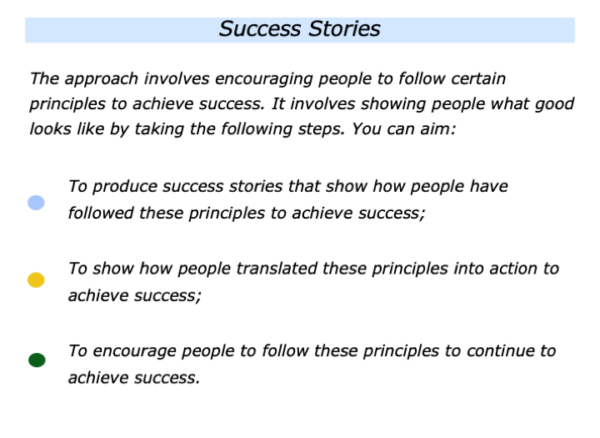
There are many ways to share positive paradigms. As mentioned earlier, however, it is vital to share these in a way: a) that resonates with people; b) that shows the benefits; c) that shows how people can achieve success.
Let’s return to your own life and work. Looking ahead, can you think of a situation where you may want to follow elements of this approach? This could be in your personal or professional life.
If you wish, try tackling the exercise on this theme. This invites you to complete the following sentences.
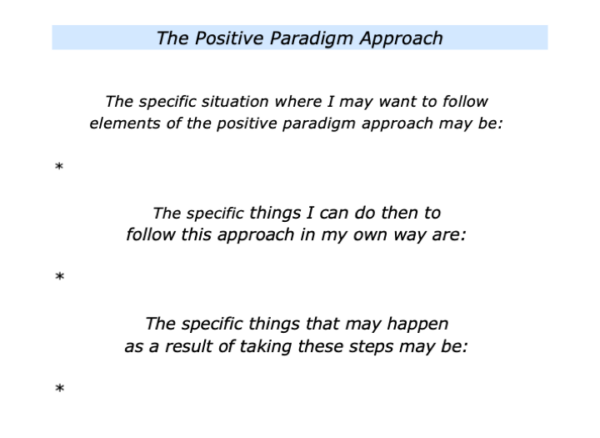






Leave a Reply